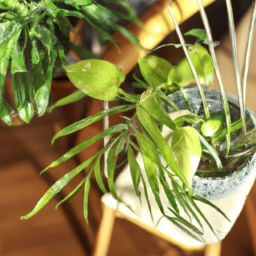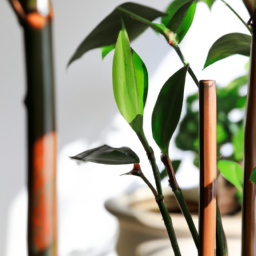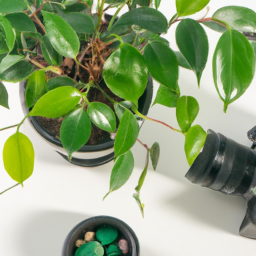
Have you ever wondered, “Can you keep outdoor plants indoors?” Many gardeners face this dilemma when the seasons change or when they want to bring their favorite plants inside. In this blog post, we will explore the possibilities of keeping outdoor plants indoors and provide tips on how to successfully transition your plants from the garden to your home. Whether you have a green thumb or are just starting out, this guide will help you navigate the world of indoor gardening with ease. So, let’s dig in and discover how you can bring the beauty of the outdoors inside!
Benefits of Bringing Outdoor Plants Indoors
Improved Air Quality
One of the main benefits of bringing outdoor plants indoors is the improvement in air quality. Plants are natural air purifiers, absorbing carbon dioxide and releasing oxygen through the process of photosynthesis. This can help to reduce indoor air pollution caused by chemicals, dust, and other toxins. In addition, plants can also help to increase humidity levels in the air, which can be beneficial for those living in dry climates or during the winter months.
Indoor plants can also help to remove harmful toxins from the air, such as formaldehyde, benzene, and trichloroethylene, which are commonly found in household products and furnishings. By bringing outdoor plants indoors, you can create a healthier and more pleasant living environment for yourself and your family.
Furthermore, studies have shown that indoor plants can help to improve concentration, productivity, and overall well-being. By having plants in your home, you can create a calming and peaceful atmosphere that can help to reduce stress and anxiety.
Enhanced Décor
Another benefit of bringing outdoor plants indoors is the enhancement of your home décor. Plants can add a touch of nature and beauty to any room, creating a more inviting and relaxing space. Whether you choose to display a few small plants on a windowsill or create a lush indoor garden, plants can help to brighten up your home and make it feel more vibrant.
There are countless varieties of indoor plants to choose from, ranging from low-maintenance succulents to colorful flowering plants. You can mix and match different plants to create a unique and personalized indoor oasis that reflects your style and personality. In addition, plants can be used to fill empty corners, add height to a room, or create a focal point in a space.
By bringing outdoor plants indoors, you can transform your home into a green sanctuary that brings joy and beauty to your everyday life. Plants can help to create a sense of tranquility and harmony in your home, making it a more peaceful and welcoming place to be.
Year-Round Gardening
Bringing outdoor plants indoors allows you to enjoy gardening year-round, regardless of the season or weather conditions outside. By creating an indoor garden, you can grow a wide variety of plants, herbs, and vegetables throughout the year, even during the cold winter months. This can be especially beneficial for those who live in regions with harsh winters or limited outdoor gardening space.
Indoor gardening can be a rewarding and fulfilling hobby that allows you to connect with nature and nurture living things. You can experiment with different plant varieties, growing techniques, and design ideas to create a thriving indoor garden that brings you joy and satisfaction. In addition, indoor gardening can help to improve your mood, reduce stress, and provide a sense of accomplishment.
By bringing outdoor plants indoors, you can extend the growing season, expand your gardening skills, and enjoy the beauty of nature all year long. Whether you have a green thumb or are new to gardening, indoor plants can provide endless opportunities for creativity and growth.

Tips for Successfully Transitioning Outdoor Plants Indoors
Understanding the Basics
When it comes to transitioning outdoor plants indoors, there are a few key factors to keep in mind. First and foremost, it’s important to understand the specific needs of the plants you are working with. Different plants have different requirements when it comes to sunlight, water, and temperature, so it’s essential to do your research before making the transition.
One of the most important things to consider is the amount of sunlight your plants will receive indoors. Outdoor plants are used to being exposed to direct sunlight for most of the day, so it’s crucial to place them in a location where they will still get plenty of light. If possible, try to mimic the amount of sunlight they were receiving outdoors by placing them near a south-facing window or using grow lights.
In addition to sunlight, it’s also important to pay attention to the temperature and humidity levels in your home. Outdoor plants are accustomed to fluctuating temperatures and higher levels of humidity, so you may need to make some adjustments to create a suitable environment for them indoors. Consider using a humidifier to increase the moisture in the air, and be mindful of any drafts or temperature changes that could affect your plants.
Another key factor to consider is the type of soil your plants are in. Outdoor plants are typically planted in soil that allows for good drainage, so it’s important to choose a high-quality potting mix that will provide adequate drainage and nutrients for your plants. Be sure to repot your plants if necessary, and consider adding some fertilizer to help them adjust to their new environment.
Taking Care of Your Plants
Once you have successfully transitioned your outdoor plants indoors, it’s important to continue to provide them with the care they need to thrive. Regular watering is essential, but be careful not to overwater your plants, as this can lead to root rot and other issues. Check the soil regularly to ensure it is moist but not waterlogged, and adjust your watering schedule as needed.
In addition to watering, it’s also important to monitor the health of your plants and watch for any signs of stress or disease. Keep an eye out for yellowing leaves, wilting, or unusual growth patterns, as these can be indicators that your plants are not receiving the proper care. If you notice any issues, take action promptly to address them and prevent further damage.
Another important aspect of caring for your indoor plants is regular pruning and maintenance. Outdoor plants may need to be pruned more frequently when grown indoors, as they may not have access to natural elements like wind and rain that help keep them in check. Be sure to remove any dead or damaged leaves, stems, or flowers, and consider repotting your plants if they outgrow their containers.
Maintaining a Healthy Environment
In addition to providing your plants with the care they need, it’s also important to create a healthy environment for them to thrive in. This includes ensuring they have adequate light, temperature, and humidity levels, as well as protecting them from pests and diseases. Consider using natural pest control methods, such as neem oil or insecticidal soap, to keep pests at bay without harming your plants.
It’s also important to keep your plants clean and free of dust and debris, as this can inhibit their ability to photosynthesize and grow. Regularly wipe down the leaves of your plants with a damp cloth to remove any buildup, and consider giving them a gentle shower or bath every once in a while to keep them looking their best.
Overall, successfully transitioning outdoor plants indoors requires careful planning, attention to detail, and a willingness to adapt to the needs of your plants. By following these tips and providing your plants with the care they need, you can create a thriving indoor garden that will bring beauty and life to your home.

Common Mistakes to Avoid When Keeping Outdoor Plants Indoors
Bringing outdoor plants indoors can be a great way to enjoy your favorite greenery year-round, but it’s important to do so carefully to ensure the health and longevity of your plants. There are several common mistakes that people make when transitioning their outdoor plants to an indoor environment. By avoiding these mistakes, you can help your plants thrive indoors.
1. Neglecting Proper Lighting
One of the most common mistakes people make when bringing outdoor plants indoors is neglecting to provide them with adequate lighting. Outdoor plants are accustomed to receiving direct sunlight for several hours a day, so it’s important to replicate this environment as closely as possible indoors. Place your plants near a south-facing window where they can receive plenty of natural light throughout the day. If natural light is limited in your home, consider supplementing with a grow light to ensure your plants get the light they need to thrive.
It’s also important to pay attention to the specific light requirements of each plant. Some plants require more sunlight than others, so be sure to research the lighting needs of each plant in your collection and place them accordingly.
In addition to providing adequate light, be mindful of the temperature and humidity levels in your home. Most outdoor plants prefer a warm, humid environment, so consider using a humidifier to maintain the ideal conditions for your plants.
2. Overwatering or Underwatering
Another common mistake when keeping outdoor plants indoors is overwatering or underwatering. Outdoor plants typically require less frequent watering than indoor plants, as they have access to natural rainfall and drainage. When transitioning your plants indoors, it’s important to adjust your watering schedule accordingly.
Before watering your plants, always check the soil moisture level to determine if it’s time for watering. Stick your finger into the soil up to the first knuckle – if the soil feels dry, it’s time to water. Be sure to water your plants thoroughly, allowing excess water to drain out of the bottom of the pot to prevent waterlogged roots.
On the other hand, underwatering can also be detrimental to your plants. If you notice wilting leaves or dry, crispy foliage, your plants may be thirsty. Be sure to water your plants consistently and adjust your watering schedule as needed based on the individual needs of each plant.
3. Ignoring Pest and Disease Management
One often overlooked aspect of keeping outdoor plants indoors is pest and disease management. Outdoor plants are more susceptible to pests and diseases when brought indoors, as they are no longer exposed to natural predators and environmental factors that help control these issues. It’s important to regularly inspect your plants for signs of pests or diseases and take proactive measures to prevent infestations.
To prevent pests, you can use natural remedies such as neem oil or insecticidal soap, or introduce beneficial insects like ladybugs to help control pest populations. It’s also important to isolate any infected plants to prevent the spread of pests or diseases to other plants in your collection.
In addition to pest management, be sure to maintain good plant hygiene by regularly cleaning your plants, removing dead or decaying foliage, and avoiding overcrowding. Proper air circulation and spacing between plants can help prevent the spread of diseases and keep your plants healthy and thriving.
In a Nutshell
Have you ever wondered if you can keep your outdoor plants indoors? The answer is yes, but it requires some careful consideration and planning. While many outdoor plants can thrive indoors, others may struggle due to differences in light, temperature, and humidity levels.
Before bringing your outdoor plants inside, it’s important to assess their specific needs and make any necessary adjustments to their new environment. Consider factors such as the amount of sunlight they require, the temperature of your home, and the humidity levels. Additionally, be mindful of potential pests or diseases that may be brought indoors with the plants. With proper care and attention, you can successfully keep outdoor plants indoors and enjoy their beauty year-round.
FAQ Compilation:
Q1. Can outdoor plants survive indoors?
Outdoor plants can survive indoors, but it depends on the specific plant and its needs. Some outdoor plants may struggle to adapt to indoor conditions, while others may thrive with the right care.
Q2. How can I keep outdoor plants healthy indoors?
To keep outdoor plants healthy indoors, make sure they are getting enough sunlight, water, and nutrients. You may need to supplement with artificial light or fertilizer to mimic outdoor conditions.
Q3. What are some common challenges of keeping outdoor plants indoors?
Some common challenges of keeping outdoor plants indoors include adjusting to lower light levels, dealing with pests that may be brought indoors, and providing the right amount of humidity.
Q4. Can I bring my outdoor plants indoors during the winter?
Yes, you can bring outdoor plants indoors during the winter to protect them from cold temperatures. Just be sure to gradually acclimate them to indoor conditions to prevent shock.
Q5. Are there any outdoor plants that are better suited for indoor living?
Some outdoor plants, such as succulents, ferns, and certain tropical plants, are better suited for indoor living due to their ability to thrive in lower light levels and indoor temperatures.
Dr. Olivia Green is a botanist with over two decades of experience in indoor plant cultivation. She holds a Ph.D. in Plant Biology and has dedicated her career to researching plant behavior in controlled environments. Dr. Green is passionate about helping plant enthusiasts master the art of indoor gardening through her extensive knowledge and practical insights.


